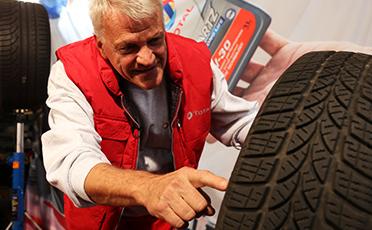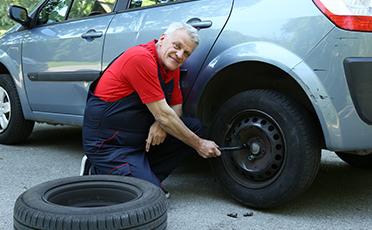
10 concerns about car tires

The most precise way to refer to a car tire is “pneumatic rubber tire”. The local, widely accepted term is simply “rubber”.
1. Winter tires are mandatory from November 1, until April 1
This statement is commonly used as a reminder to all drivers to adhere to the Regulations in the area of vehicle type and technical requirements for participating in traffic. A typical concern many divers have is whether they would be fined if caught with the wrong kind of tires during this period. In order to clarify this, we will quote the Regulations first:
“From November 1 until April 1, vehicles must be equipped for winter if there is snow, ice or glazed frost on the road.” Winter equipment, among other things, means you need to have “tires designed for winter use (e.g., M+S, Snow Winter etc.) on all four wheels for vehicle types M1 and N1”.
Therefore, if you get pulled over by a police officer during this period, and you do not have your winter tires fitted, you need not worry about fines unless the road is covered in snow, ice or glazed frost. However, do bear in mind that the performance of summer tires decreases at temperatures below 7℃, so for your own safety, do not take this risk because the weather conditions may change unexpectedly and catch you off guard.
2. You can use the same tires throughout the whole year
This misconception is primarily related to the use of universal or all-season tires. What one needs to take into consideration however, is that using all season tires is recommended in areas with mild winters. As temperatures get more extreme, performance and safety go in favor of winter/summer tires.
Although in Serbia all-season tires fulfill the legal requirements, marked by M+S or variations such as MS and M+S, considering the climate which sometimes brings harsh winter conditions, it is recommended to use higher quality winter tires.
There are, however, drivers who claim that one set of tires, be it winter or summer, serves them well throughout the year. Although they may not have had bad experience, there is always a safety risk.
The composition of winter tires is softer than the one used in summer tires, so winter tires wear out more quickly when the weather is warm. As the temperature rises, traction becomes less effective, compromising the control over the vehicle. On the other hand, the composition of summer tires, their hardness and tread pattern are completely different from those in winter tires, so using summer tires in winter conditions can be very dangerous, besides being potentially fineable.
3. In case it snows, chains are mandatory outside of urban areas
If the road is covered in snow, and you are driving outside of an urban area, chains and other pieces of equipment used to increase traction are mandatory at least on two drive wheels, if that part of the road is marked with a “snow chains” sign.
If there is no such sign, chains can be fitted ONLY WHEN the road is covered in snow. If there is no snow on the road, besides being unnecessary, chains destroy tires and compromise the safety of your vehicle.

How to fit snow chains
In an urban area, you don’t need to fit equipment to increase traction. A solid quality winter tire is good enough to keep you safe during the entire winter.
4. I am not allowed to change the dimensions of my tires
Changing tire dimensions is possible, under specific conditions. The easiest and safest way is to stick to the manufacturer’s recommendation because they have already calculated parameters like speed, mass, space needed to fit brakes, etc. The manufacturer usually states several possible tire dimensions for a single car model.
On the other hand, it is possible to fit tires of different dimensions, if the sum of the rim diameter and the tire’s sidewall height is the same as that of the tire recommended by the manufacturer. In other words, if the two tires are of the same height when placed next to each other. The general recommendation is not to have more than - 3% or + 3% deviation from the original, and that the new tires are suitable to fit the rim.
Bear in mind that modern cars have electronic systems which are calibrated to specific dimensions, so deviating from these could lead to sending wrong data through the sensors.
Since the issue only gets more complicated as we go further, make sure you consult a tire specialist or a tire calculator before making a decision. In some cases, insurance companies will not accept the insurance, neither will the tire manufacturer accept warranty claims, if the dimensions do not correspond to what the vehicle manufacturer has recommended.
5. The lower the tire profile, the faster the car
Talking about the so-called low profile tires, we mean those that have bigger rim diameters and lower tire sidewalls compared to standard tires. Because of their attractiveness and the speed they reach when driving straights, low profile tires are preferred by people who are passionate about the sports looks, and those who compete on race tracks alike.
Although it is true that low profile tire achieves greater speed, bear in mind that at extremely high speeds and pressures they are not so good at cornering, making them less safe and less comfortable compared to a standard tire. For off-road driving it is recommended to opt for higher profile tires.
6. The wider the tire, the more stable the drive
Many will conclude that wider tires provide greater stability, because of what we see in Formula 1 which is one of the fastest four-wheel races in the world. Indeed, it seems quite logical that a wider tire provides better traction, considering the surface that is in contact with the ground.
However, this is true only for dry weather.
The situation changes when the road is muddy, wet or covered in snow, because then the wider surface makes it more difficult to retain stability. Among other things, a wider tire needs more effective draining than a standard one in order to avoid aquaplaning.
7. All four tires have to be identical
The Regulations say that tires of the same manufacturer, type (winter or summer), construction (radial, cross or belted bias), load index and dimensions must be fitted on the same (front or back) drive axis.
So, if in doubt whether you have to replace all four tires at once, the answer is no. If you fit only two tires, a general recommendation is to put the better pair on the drive wheels.
8. Old tires are not safe to use
There are many factors that influence tire wear, starting with proper fitting and balancing, regular pressure control, driving conditions, weather and most of all, the way the tires are stored.

Quick tire check-up
In essence, the Law does not define a deadline after which tires are no longer allowed to be sold. However, many manufacturers recommend consulting an expert or asking the manufacturer for opinion if the tires are older than 5 years. Tires that are older than 10 years ought to be replaced.
If you opt for tires with an older date of manufacture, make sure you are buying from trusted tire dealers who store them properly.
9. Retreaded tires are of poor quality
Retreaded tires are those who have their worn or damaged tread layer replaced with a new one. Contrary to the popular belief that this is done for the purpose of lowering expenses, the motive is actually eco-friendliness - reducing the total number of tires in use, saving natural resources, lowering CO2 emissions and the overall amount of waste. Tires can be retreaded for a maximum of 3 times, after which they get recycled.
Of course, in order to be safe and usable, a retreaded tire must be homologated, meaning that it must have a valid certificate in accordance with the highest European standards.
Manufacturers who retread tires are obliged to test them the same way as it is done with new tires, in line with all the safety and performance criteria.
10. The letter E followed by a number tells you about the class of the tire
At the time of great socio-economic crisis in this part of the world, many domestic manufacturers lacked resources so they added plastic to the tire composition. The number that followed the letter “E” marked the percentage of plastic used to make the tire, i.e., the “class” of the tire.
However, this is no longer the case. The letter “E” means that the tire fulfills all the EU requirements with regards to quality, and that it possesses a certain E certificate (homologation). The number next to the letter “E” represents the code of the country which issued the E certificate and has nothing to do with the quality of the tire. For Serbia, this mark is E10.
In the context of modern times, tires are roughly divided into economy, standard and premium class. Class is usually chosen based on the driving conditions, the driver’s needs and available budget.
We hope you found this article useful. DON’T MISS more content recommended below and feel free to contact us for any questions, concerns and suggestions you may have.






